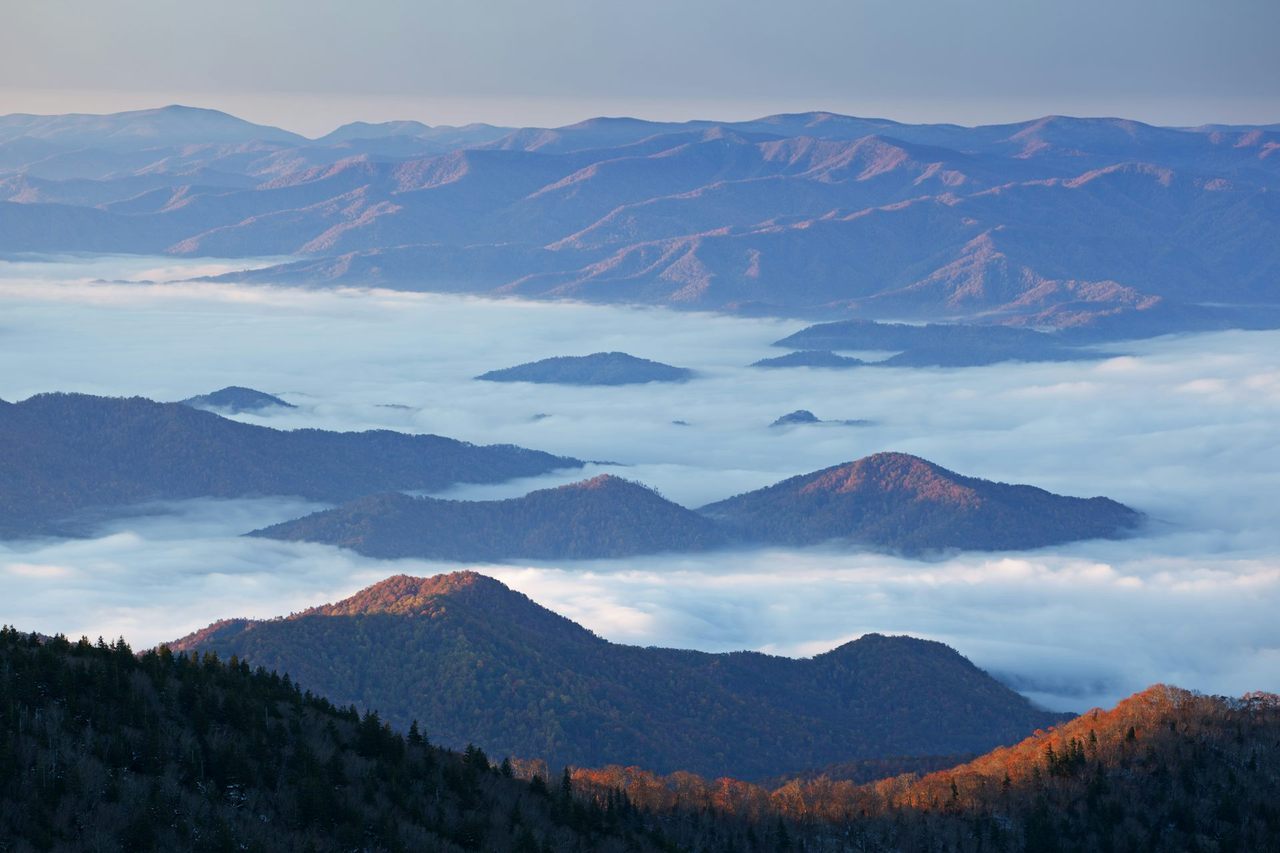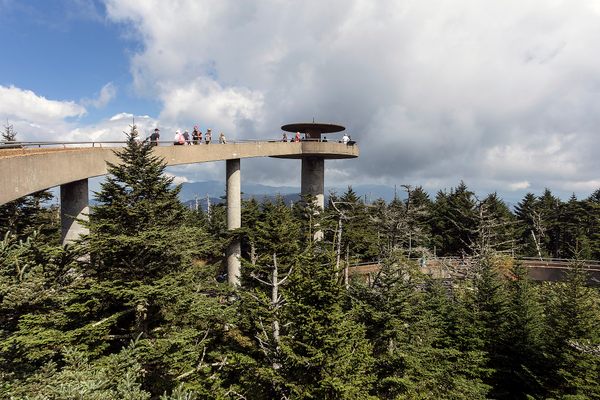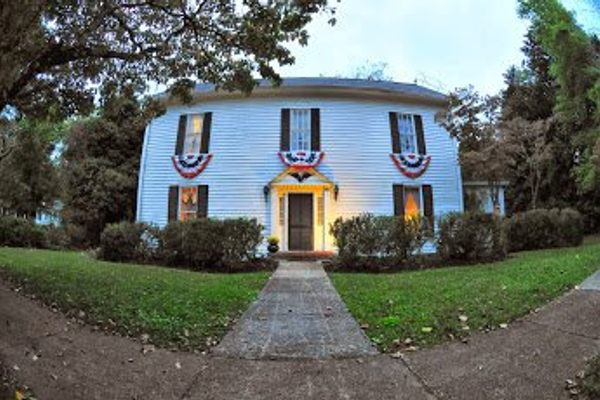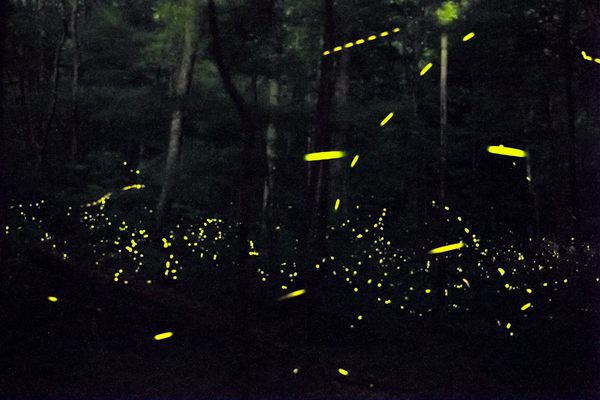The Tallest of the Great Smoky Mountains Is—Officially—Kuwohi
The return of the indigenous name of Tennessee’s highest point has meaning beyond what’s on a map.
This story was originally published on The Conversation. It appears here under a Creative Commons license.
It’s not every day that the name of a mountain is restored to the one used by Indigenous peoples for centuries. But after nearly two years of trying, the Eastern Band of Cherokee Indians finally convinced the United States Board on Geographic Names on Sept. 18 to formally agree to rename the highest point in the Great Smoky Mountains National Park of Tennessee to Kuwohi (koo-whoa-hee).
The mountain, known as Clingmans Dome since 1859, has been a sacred place for the Cherokee people, serving as a place of prayer, reflection, and gathering of mulberries for medicine. In fact, the name Kuwohi translates to “the mulberry place” in Tsalagi, the Cherokee language.
Though the peak was known as Kuwohi by the Cherokee people for hundreds of years, explorer Arnold Guyot effectively ignored that history after he surveyed the mountain range in 1859. Guyot named the peak “Clingmans Dome” after his friend Thomas Lanier Clingman, a North Carolina U.S. senator and a Confederate brigadier general during the Civil War. Clingman never set foot on this mountain, but his name remained there for 165 years, until now.
The government’s renaming of the mountain to Kuwohi is a significant example of place name repatriation, or the return of an original, Indigenous name to a particular place or landscape.

Sometimes the primary motivation for place renaming is to remove an offensive or irrelevant place name from the landscape, such as the renaming of Squaw Peak in Arizona to Piestewa Peak in 2008. In other cases, such as the renaming of Mount McKinley in Alaska to Denali in 2016, the motivation was to create a more authentic and historically accurate name for a particular place.
In the case of Kuwohi, the return to its original name was a mixture of both. The government’s decision recognized the original Indigenous name and removed the name of a white man who defended the enslavement of African people. It is also about restoring a larger sense of respect and recognition of Indigenous identity across the landscape. Just as important is the fact that it was individuals from the Eastern Band of Cherokee Indians who put forward this proposal and remained the lead throughout the process.
Place naming is only truly reparative if these processes truly reflect the agency and intent of these historically oppressed groups. Otherwise, it contributes to the long history of dismissing Indigenous claims to land and culture by not involving them.
A name is one of the most fundamental ways to identify and give meaning to places. In other words, the name of the place makes a big difference in how people perceive it.

There is growing public recognition that place names can transmit harmful messages that misrepresent the history and identity of minority communities. Place names also can demonstrate how those in power have used them to disrespect and misrepresent ethnic and racial groups that have been historically discriminated against.
For those groups, the U.S. Department of the Interior’s Advisory Committee on Reconciliation in Place Names found in 2022 that derogatory place names are a source of recurring trauma.
If place naming did not matter, disputes over name changes would not occur. Some critics find place renaming to be an example of unnecessary political correctness, while others see it as a meaningful solution that will leave a lasting positive impact.
The elimination of names of Confederate generals from some U.S. military bases provides another example. Former President Donald Trump has pledged to restore the name “Fort Bragg” to the North Carolina Army base that’s known today as Fort Liberty if reelected. Originally named after Braxton Bragg, a slave-owning Confederate general, the fort was one of nine U.S. installations that the Defense Department ordered in 2023 to have their names changed to among 3,700 recommendations.
Trump’s stance exemplifies the backlash that has occurred against local and state school officials across the country who have removed the names of Confederate generals and others from public buildings. Despite such backlash, efforts by Indigenous people and civil rights advocates slowly move forward and are seen across the U.S. in places like streets, neighborhoods, college campuses and beyond.
For Lavita Hill and Mary Crowe, the two members of the Eastern Band of Cherokee Indians who took the lead on submitting the proposal, the renaming of Kuwohi was a moment of success. Their campaign was heavily inspired by the renaming of Mount Doane to First Peoples Mountain in Yellowstone National Park in 2022.
Crowe told reporters that she saw friends and relatives shed tears when they learned of the name change. “It was humbling,” she said. “It was beautiful.”

The success of the effort to restore the name Kuwohi may help other communities in their ongoing place renaming efforts. One such proposal involves a 100-year-old fight to rename Mount Rainier in Washington state to “Tacoma,” the original name given to it by the Salish people of the Pacific Northwest. This movement began in 1924 among the Salish and other groups because Peter Rainier, for whom the mountain was named in 1792, was a British naval officer who was known as being “anti-American.”
Another example is a push by 20 different Indigenous tribes, including the Lakota Nation and the Oglala Sioux Tribe, to rename Devils Tower in Wyoming to Bear Lodge. The current name of this butte resulted from a poor English translation of the original Indigenous name of “bear lodge” to “bad god’s tower.” Over time, the name was simplified to “Devils Tower.”
As geographers who have studied the significance of place renaming, we have learned that it is important to engage the folks that these movements will benefit most in all conversations and decisions. What is at stake is not just removing insulting names, but also ensuring that the process of changing place names is collaborative of all Americans, especially historically oppressed communities, to truly be restorative and meaningful for society.
Seth T. Kannarr is a Ph.D. student in geography at the University of Tennessee and Derek H. Alderman is chancellor’s professor of geography at the University of Tennessee.





























Follow us on Twitter to get the latest on the world's hidden wonders.
Like us on Facebook to get the latest on the world's hidden wonders.
Follow us on Twitter Like us on Facebook